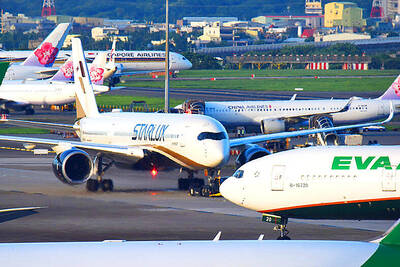The nation's most urgent environmental issue is to follow international guidelines on greenhouse gas emission controls, Environmental Protection Administration (EPA) Deputy Minister Chang Feng-teng (張豐藤) told a press conference yesterday.
The UN Climate Change Conference ended on Saturday with the adoption of the Bali Roadmap, Chang said.
"The roadmap is a charted course aimed at reaching an international agreement to combat global warming for the post-Kyoto Protocol era [2012] by 2009," he said.
Chang, who headed the nation's representatives to the conference, said the goal of their attendance was two-fold: to grasp the latest developments in international standards for fighting climate change, "so that we can make laws accordingly" and, "to let the international community hear our voice."
"As the first non-Kyoto Protocol member to propose a greenhouse gas emission policy, several developed countries, such as Japan, were impressed with Taiwan's efforts to participate at the international level," Chang said.
At a separate press conference yesterday, the Taiwan Green Party and non-governmental organizations, including Taiwan Environmental Active Network (TEAN) and Taiwan Environmental Information Association (TEIA), also shared their thoughts on the Bali meetings.
"The Bali Roadmap places responsibility on developed countries to aid developing ones, requesting that the former establish Adaptation Funds as well as technology transfers to the latter," TEIA editor-in-chief Peng Jui-hsiang (彭瑞祥) said.
The roadmap also seeks to address deforestation, Peng said.
Several important agreements were reached at this year's conference, TEAN's Cheng I-chin (鄭一青) said.
"Developed countries are raising the bar for themselves. For example, the EU's original goal was to reduce carbon emissions by 20 percent in 2020. They have increased that to 30 percent," she said.
"In the post-2012 era, the leading 25 countries, including Taiwan, who are responsible for 83 percent of global emissions, will be key targets for greenhouse gas emission reduction," she said.
In addition to the roadmap, the UN's 13th Conference of Parties (COP13), attended by city alliances, reached an agreement to reduce their carbon emissions to 60 percent of 1990 levels by 2050, she said.
In response to the Bali Roadmap, the groups made three requests to the government.
"We should have policies aimed to reducing carbon emission by 50 percent by 2050 as per international trends," Cheng said.
"Taiwan cannot play the `non-UN member' card anymore," she said.
"Since COP13 participants consist of the International Council for Local Environmental Initiatives, which includes Taipei and Kaohsiung, and United Cities and Local Governments, which includes Taichung, we should see ourselves as part of the global effort," she said.
The last request concerned governmental control of Taiwanese manufacturers and businesses, Cheng said.
During COP13, the groups collected signatures from international representatives against the construction of "major mistakes in environmental protection," Cheng said.
"The government must reconsider building these monstrosities that would make us international outcasts in the fight against carbon emission reduction," Cheng said.
Using the proposals to build Formosa Plastic Group's steel plant and the Suhua Freeway linking Ilan and Hualien as examples, she said that: "Developing countries such as South Africa and Brazil, in recognition of the impact of climate change to the survival or humanity, are voluntarily participating in a long term battle against it."
"Taiwan, as a big emitter of carbon in Asia, can no longer afford to be a bystander," she said.

The disruption of 941 flights in and out of Taiwan due to China’s large-scale military exercises was no accident, but rather the result of a “quasi-blockade” used to simulate creating the air and sea routes needed for an amphibious landing, a military expert said. The disruptions occurred on Tuesday and lasted about 10 hours as China conducted live-fire drills in the Taiwan Strait. The Civil Aviation Administration (CAA) said the exercises affected 857 international flights and 84 domestic flights, affecting more than 100,000 travelers. Su Tzu-yun (蘇紫雲), a research fellow at the government-sponsored Institute for National Defense and Security Research, said the air

Taiwan is to commence mass production of the Tien Kung (天弓, “Sky Bow”) III, IV and V missiles by the second quarter of this year if the legislature approves the government’s NT$1.25 trillion (US$39.78 billion) special defense budget, an official said yesterday. Commenting on condition of anonymity, a defense official with knowledge of the matter said that the advanced systems are expected to provide crucial capabilities against ballistic and cruise missiles for the proposed “T-Dome,” an advanced, multi-layered air defense network. The Tien Kung III is an air defense missile with a maximum interception altitude of 35km. The Tien Kung IV and V

Trips for more than 100,000 international and domestic air travelers could be disrupted as China launches a military exercise around Taiwan today, Taiwan’s Civil Aviation Administration (CAA) said yesterday. The exercise could affect nearly 900 flights scheduled to enter the Taipei Flight Information Region (FIR) during the exercise window, it added. A notice issued by the Chinese Civil Aviation Administration showed there would be seven temporary zones around the Taiwan Strait which would be used for live-fire exercises, lasting from 8am to 6pm today. All aircraft are prohibited from entering during exercise, it says. Taipei FIR has 14 international air routes and

Taiwan lacks effective and cost-efficient armaments to intercept rockets, making the planned “T-Dome” interception system necessary, two experts said on Tuesday. The concerns were raised after China’s military fired two waves of rockets during live-fire drills around Taiwan on Tuesday, part of two-day exercises code-named “Justice Mission 2025.” The first wave involved 17 rockets launched at 9am from Pingtan in China’s Fujian Province, according to Lieutenant General Hsieh Jih-sheng (謝日升) of the Office of the Deputy Chief of the General Staff for Intelligence at the Ministry of National Defense. Those rockets landed 70 nautical miles (129.6km) northeast of Keelung without flying over Taiwan,